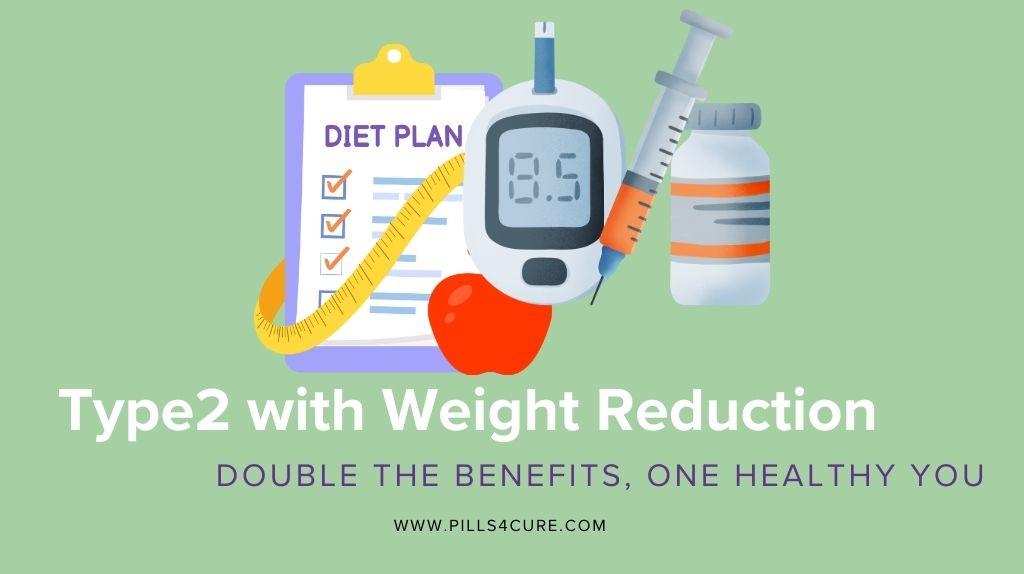Weight Reduction with Type 2 Diabetics: Natural and Effective Approaches

Living with type 2 diabetes presents unique challenges, particularly when it comes to managing weight. For millions of people across the United Kingdom, understanding the connection between weight reduction and diabetes management has become increasingly crucial. The weight reduction meaning extends far beyond aesthetics; it's about reclaiming your health, improving blood sugar control, and reducing the risk of comorbid conditions that often accompany diabetes.
Type 2 diabetes means your body struggles to use insulin effectively, leading to elevated blood glucose levels. This metabolic condition affects how your body processes sugar, and excess weight can significantly worsen insulin resistance. The encouraging news? Even modest weight loss of 5-10% of your body weight can dramatically improve diabetes management and overall well-being.
This comprehensive guide explores natural, evidence-based approaches to weight reduction specifically tailored for individuals managing type 2 diabetes. We'll examine lifestyle modifications, dietary strategies, emerging treatments, including a new generation formulation of diabetic medications, like Rybelsus 7 mg and practical steps you can implement today.
Understanding Type 2 Diabetes and Weight Connection
What Type 2 Diabetes Means for Your Body
Type 2 diabetes means your pancreas doesn't produce enough insulin or your cells resist insulin's effects. This creates a cascade of metabolic challenges that directly impact weight management. Insulin resistance causes your body to store more fat, particularly around the abdomen, whilst elevated insulin levels increase hunger and make weight loss more difficult.
The Vicious Cycle
Excess weight worsens insulin resistance, which in turn makes it harder to lose weight—creating a frustrating cycle. Breaking this pattern requires a multifaceted approach addressing both blood sugar control and sustainable weight reduction.
Signs of Type 2 Diabetes
Recognising the signs of type 2 diabetes early can help you take prompt action:
- Increased thirst and frequent urination
- Persistent fatigue and low energy levels
- Blurred vision that comes and goes
- Slow-healing wounds or frequent infections
- Tingling or numbness in hands or feet
- Unexplained weight changes
- Increased hunger, especially after eating
- Dark patches of skin in body creases (acanthosis nigricans)
If you're experiencing several of these symptoms alongside difficulty managing your weight, consult your GP for proper assessment.
Natural Weight Reduction Strategies for Type 2 Diabetics
1. Adopting a Type 2 Diabetes Diet
A proper type 2 diabetes diet forms the foundation of successful weight reduction. Unlike restrictive fad diets, a sustainable eating plan focuses on:
Low Glycaemic Index Foods: Choose wholegrains, legumes, and non-starchy vegetables that release energy slowly, preventing blood sugar spikes and maintaining satiety.
Portion Control: Understanding appropriate serving sizes helps manage calorie intake without feeling deprived. Using smaller plates and measuring portions initially can establish healthy habits.
Balanced Macronutrients: Include lean proteins (chicken, fish, tofu), healthy fats (avocados, nuts, olive oil), and complex carbohydrates whilst limiting refined sugars and processed foods.
Mediterranean-Style Eating: Rich in vegetables, fruits, wholegrains, legumes, and healthy fats, this approach has shown remarkable benefits for both weight loss and diabetes management.
2. Regular Physical Activity
Exercise improves insulin sensitivity and burns calories, making it invaluable for weight reduction:
Cardiovascular Exercise: Aim for 150 minutes weekly of moderate-intensity activities like brisk walking, cycling, or swimming.
Resistance Training: Building muscle mass increases metabolic rate and improves glucose uptake. Include strength training 2-3 times weekly.
Daily Movement: Break up sedentary time with short walks, stretching, or light activities throughout the day.
3. Sleep and Stress Management
Poor sleep and chronic stress elevate cortisol levels, promoting weight gain and worsening insulin resistance:
- Prioritise 7-9 hours of quality sleep nightly
- Practice stress-reduction techniques like meditation, yoga, or deep breathing
- Maintain consistent sleep-wake schedules
- Create a relaxing bedtime routine
4. Hydration
Adequate water intake supports metabolism, reduces false hunger signals, and helps regulate blood sugar levels. Aim for 6-8 glasses daily, adjusting for activity level and climate.
Medical Approaches to Weight Reduction
GLP-1 Agonists: A Revolutionary Approach
GLP-1 agonists represent a breakthrough in diabetes and weight management. These medications mimic naturally occurring hormones that regulate appetite and blood sugar.
How They Work: GLP-1 agonists slow gastric emptying, reduce appetite, increase insulin secretion when needed, and decrease inappropriate glucagon release. This combination promotes both better glucose control and significant weight reduction.
Semaglutide 3 mg: Amongst GLP-1 agonists, semaglutide has demonstrated exceptional results. Originally developed for diabetes management, studies show that semaglutide can lead to substantial weight loss—often 10-15% of body weight when combined with lifestyle modifications.
Novo Nordisk and Innovation
Novo Nordisk, a leading pharmaceutical company, has pioneered several diabetes treatments including various formulations of semaglutide. Their research has contributed significantly to understanding how targeted therapies can address both diabetes management and weight reduction simultaneously.
A New Generation Formulation
Recent advances have produced a new generation formulation of weight management medications specifically designed for improved efficacy and convenience. These treatments offer:
- Once-weekly dosing for better adherence
- Enhanced weight reduction results
- Improved side effect profiles
- Better cardiovascular outcomes
Weight Reduction Pills: What You Should Know
The weight reduction pills market includes various options, from over-the-counter supplements to prescription medications. For those with type 2 diabetes, prescription options like GLP-1 agonists are generally most effective and safe when properly supervised.
Important Considerations:
- Always consult your healthcare provider before starting any weight reduction pills
- Medications work best alongside lifestyle changes, not as replacements
- Regular monitoring ensures safety and effectiveness
- Some supplements may interact with diabetes medications
Managing Comorbid Conditions
Understanding Comorbid Condition Challenges
A comorbid condition refers to the presence of multiple health issues simultaneously. Type 2 diabetes rarely exists in isolation—it frequently accompanies:
- Hypertension (high blood pressure)
- Cardiovascular disease
- Dyslipidaemia (abnormal cholesterol levels)
- Non-alcoholic fatty liver disease
- Sleep apnoea
- Depression and anxiety
Weight reduction positively impacts most of these conditions, creating a ripple effect of health improvements throughout your body.
Integrated Care Approach
Managing multiple conditions requires coordinated care. Work with your healthcare team to ensure your weight reduction strategy safely addresses all your health concerns.
Precautions and Safety Considerations
Before Starting Any Weight Reduction Programme
Consult Your Healthcare Team: Always discuss weight loss plans with your GP, diabetes specialist, or registered dietitian. They'll help create a personalised strategy considering your medications, complications, and overall health.
Monitor Blood Sugar Closely: As you lose weight and change eating patterns, blood glucose levels may fluctuate. More frequent monitoring helps prevent hypoglycaemia (low blood sugar).
Medication Adjustments: Weight loss often requires diabetes medication dosage reductions. Never adjust medications without professional guidance.
Gradual Changes: Aim for steady weight loss of 0.5-1 kg weekly. Rapid weight loss can be dangerous and unsustainable.
Special Precautions with Weight Reduction Pills
If considering prescription weight reduction pills like GLP-1 agonists:
- Report any persistent nausea, vomiting, or abdominal pain
- Stay well-hydrated, especially during initial treatment
- Be aware of potential side effects including gastrointestinal symptoms
- Inform your doctor about all medications and supplements you take
- Attend all follow-up appointments for monitoring
Warning Signs Requiring Immediate Medical Attention
Seek prompt medical care if you experience:
- Severe hypoglycaemia (blood sugar below 4 mmol/L with confusion, trembling, or loss of consciousness)
- Persistent vomiting or inability to keep fluids down
- Severe abdominal pain
- Signs of pancreatitis (intense upper abdominal pain radiating to the back)
- Rapid heartbeat or chest pain
- Significant changes in mood or mental health
Contraindications
Weight reduction programmes may not be suitable if you have:
- A history of eating disorders
- Advanced diabetic complications requiring stabilisation
- Certain thyroid conditions (particularly with some GLP-1 agonists)
- Pregnancy or plans to conceive soon
- Severe kidney or liver disease
Creating Your Personalised Weight Reduction Plan
Step 1: Comprehensive Health Assessment
Begin with thorough evaluation including:
- Current weight, BMI, and waist circumference
- HbA1c and blood glucose patterns
- Blood pressure and cholesterol levels
- Assessment of any comorbid conditions
- Medication review
- Dietary and activity habits
Step 2: Set Realistic Goals
Establish achievable targets:
- Initial goal: 5-10% body weight reduction within 6 months
- Improved HbA1c by 0.5-1%
- Increased physical activity to recommended levels
- Improved energy and quality of life markers
Step 3: Develop Your Strategy
Dietary Changes:
- Work with a registered dietitian for a personalised type 2 diabetes diet
- Plan meals and snacks in advance
- Learn carbohydrate counting or plate method
- Identify and address emotional eating triggers
Exercise Programme:
- Start gradually if currently inactive
- Choose activities you enjoy for better adherence
- Schedule exercise like important appointments
- Track progress with apps or journals
Medical Support:
- Discuss whether weight reduction pills or GLP-1 agonists like semaglutide 3 mg might benefit you
- Establish regular monitoring schedule
- Plan medication adjustments as weight decreases
Step 4: Build Support Systems
- Join diabetes support groups or weight loss communities
- Involve family in healthy lifestyle changes
- Consider working with a diabetes educator
- Use technology: apps for tracking food, activity, and glucose
Step 5: Monitor and Adjust
- Track weight weekly (same day, same time)
- Monitor blood glucose regularly as directed
- Keep food and activity logs
- Schedule regular check-ups with your healthcare team
- Celebrate non-scale victories (better energy, improved sleep, looser clothing)
Long-Term Success Strategies
Maintaining Weight Loss
Sustaining weight reduction requires ongoing commitment:
Continue Healthy Habits: The behaviours that helped you lose weight must become permanent lifestyle changes.
Plan for Challenges: Identify potential obstacles (holidays, stress, travel) and develop coping strategies in advance.
Regular Self-Monitoring: Continue tracking weight, food intake, and blood sugar levels even after reaching your goal.
Stay Connected: Maintain relationships with your healthcare team and support networks.
Preventing Weight Regain
- Remain vigilant about portion sizes
- Keep unhealthy foods out of your home
- Maintain regular physical activity
- Address weight gain promptly if it occurs (more than 2-3 kg)
- Re-evaluate strategies if you hit plateaus
Adapting as You Progress
Your needs will evolve as you lose weight and manage diabetes more effectively:
- Medications may require continued adjustments
- Exercise programmes should progress in intensity
- Dietary needs may change
- New health goals may emerge
The Role of Technology and Innovation
Digital Health Tools
Modern technology offers valuable support:
Continuous Glucose Monitors (CGMs): Provide real-time glucose data, helping you understand how foods and activities affect blood sugar.
Mobile Apps: Track nutrition, exercise, medications, and glucose readings conveniently.
Telehealth Services: Access specialist support remotely, particularly valuable in rural areas of the UK.
Smart Scales and Fitness Trackers: Monitor progress and activity levels automatically.
Emerging Treatments
The landscape of diabetes and weight management continues evolving:
- Dual and triple agonist medications combining GLP-1 with other hormones
- Improved formulations of existing medications
- Personalised medicine approaches based on genetic profiles
- Novel delivery systems for better convenience
Addressing Common Barriers
"I've Tried Everything and Nothing Works"
Weight loss with diabetes is challenging, but not impossible. If previous attempts failed:
- Ensure you're addressing underlying insulin resistance
- Consider whether undiagnosed comorbid conditions are hindering progress
- Evaluate medication effects on weight
- Explore whether prescription options like GLP-1 agonists might help
- Address psychological barriers with professional support
Financial Considerations
Weight management can be achieved across various budgets:
- Focus on whole, unprocessed foods which are often economical
- Utilise NHS resources, including dietitian referrals and diabetes education programmes
- Explore patient assistance programmes for medications
- Free or low-cost exercise options (walking, home workouts, community centres)
Time Constraints
Busy lifestyles require efficient strategies:
- Meal preparation on weekends
- Quick, healthy recipes (20 minutes or less)
- Short, intense workouts if time is limited
- Incorporate activity into daily routines (stairs, walking meetings)
Frequently Asked Questions
1. How much weight should I aim to lose with type 2 diabetes?
Even modest weight loss of 5-10% of your total body weight can significantly improve blood sugar control and reduce cardiovascular risk. For someone weighing 100 kg, that's just 5-10 kg. This achievable goal often leads to better diabetes management, potentially reducing medication needs. Focus on gradual, sustainable loss rather than dramatic results.
2. Will weight reduction pills like semaglutide cure my type 2 diabetes?
Whilst weight reduction pills and GLP-1 agonists like semaglutide 3 mg can dramatically improve diabetes management and, in some cases, lead to remission, they're not a cure. Type 2 diabetes requires ongoing management. These medications work best combined with lifestyle changes including diet and exercise. Some people achieve normal blood sugar levels without medication after significant weight loss, but this requires maintaining healthy habits long-term.
3. Are there any natural alternatives to prescription weight reduction medications?
Several natural approaches support weight reduction for people with diabetes. A well-planned type 2 diabetes diet emphasising wholegrains, vegetables, lean proteins, and healthy fats forms the foundation. Regular physical activity, adequate sleep, stress management, and proper hydration all contribute significantly. Some evidence supports certain supplements like chromium, cinnamon, or berberine for blood sugar control, though effects are modest compared to prescription medications.
4. How quickly can I expect to see results from weight reduction efforts?
Results vary based on your starting point, adherence to the programme, and whether you're using medications. With lifestyle changes alone, expect to lose 0.5-1 kg weekly initially. Blood sugar improvements often appear within weeks as you reduce carbohydrate intake and increase activity. With GLP-1 agonists like semaglutide, significant weight loss typically occurs over 3-6 months, with continued progress up to a year or more.
5. What should I do if I experience side effects from weight reduction medications?
Mild side effects like nausea or digestive discomfort are common initially with GLP-1 agonists and often improve over time. Eat smaller, more frequent meals, avoid fatty foods, and stay hydrated. Never stop medications abruptly without consulting your healthcare provider.








